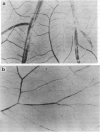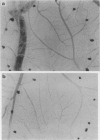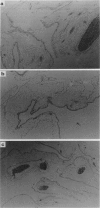Abstract
We have investigated both the effects of X-rays on angiogenesis and the possible role of nitric oxide (NO) on the observed antiangiogenic effect of X-rays, using as an in vivo model the chick embryo chorioallantoic membrane (CAM). These effects were assessed both morphologically and biochemically, by measuring vascular density and collagenous protein biosynthesis, respectively, on days 9 and 14 of the chick embryo development. Vascular density and cytotoxicity of the CAM were also evaluated histologically. We have shown that X-rays have an antiangiogenic effect on the system used and that the NO synthase inhibitor NG-nitro-L-arginine methyl ester (L-NAME) promoted angiogenesis of the non-irradiated CAM and reversed the antiangiogenic effect of irradiation. D-NAME, which is an inactive enantiomer of L-NAME, showed no such effects. L-Arginine, which is the substrate for NO synthase, had a modest antiangiogenic effect on the non-irradiated CAM, no effect on the irradiated CAM and abolished the angiogenic effect of L-NAME on these CAM preparations. These results suggest that NO is involved in the antiangiogenic mechanism of X-rays and that pharmacological manipulation of NO firstly, may offer a better understanding of these mechanisms and, secondly, may also prove to be an alternative therapeutic approach for treating pathological conditions involving angiogenesis.
Full text
PDF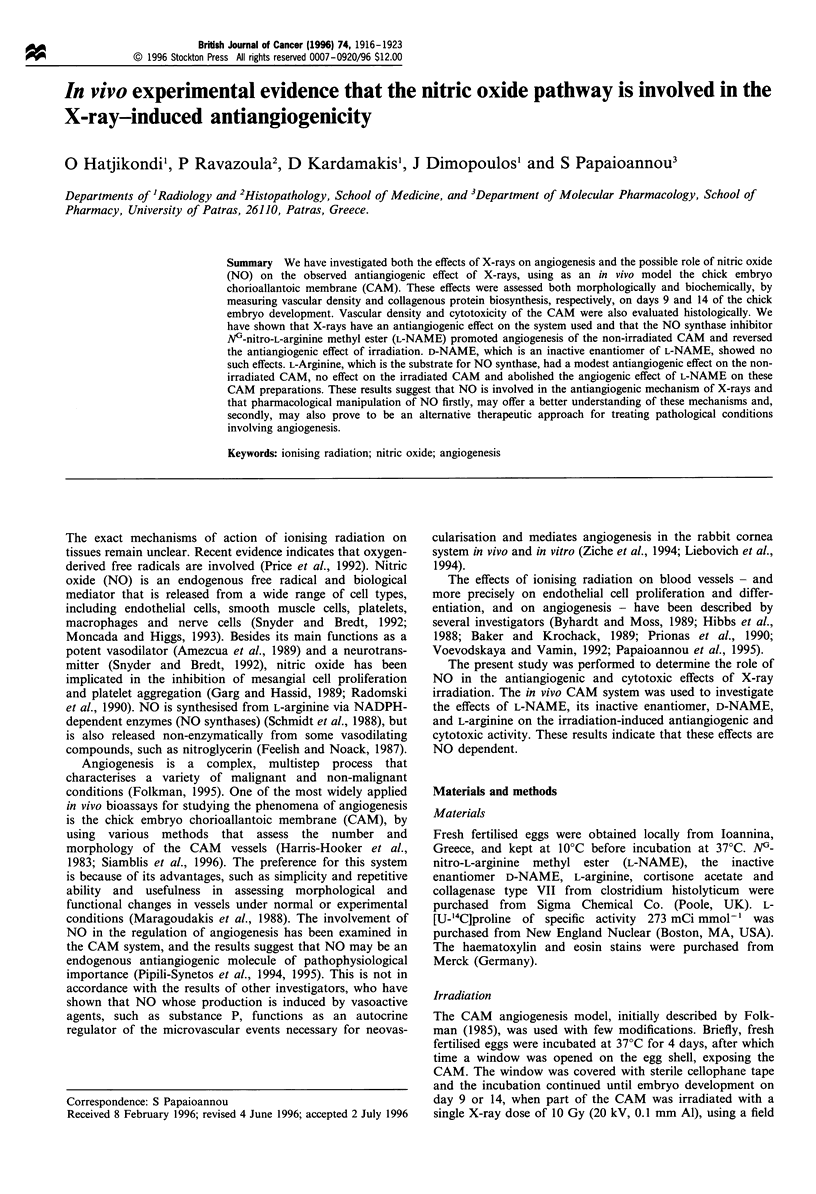
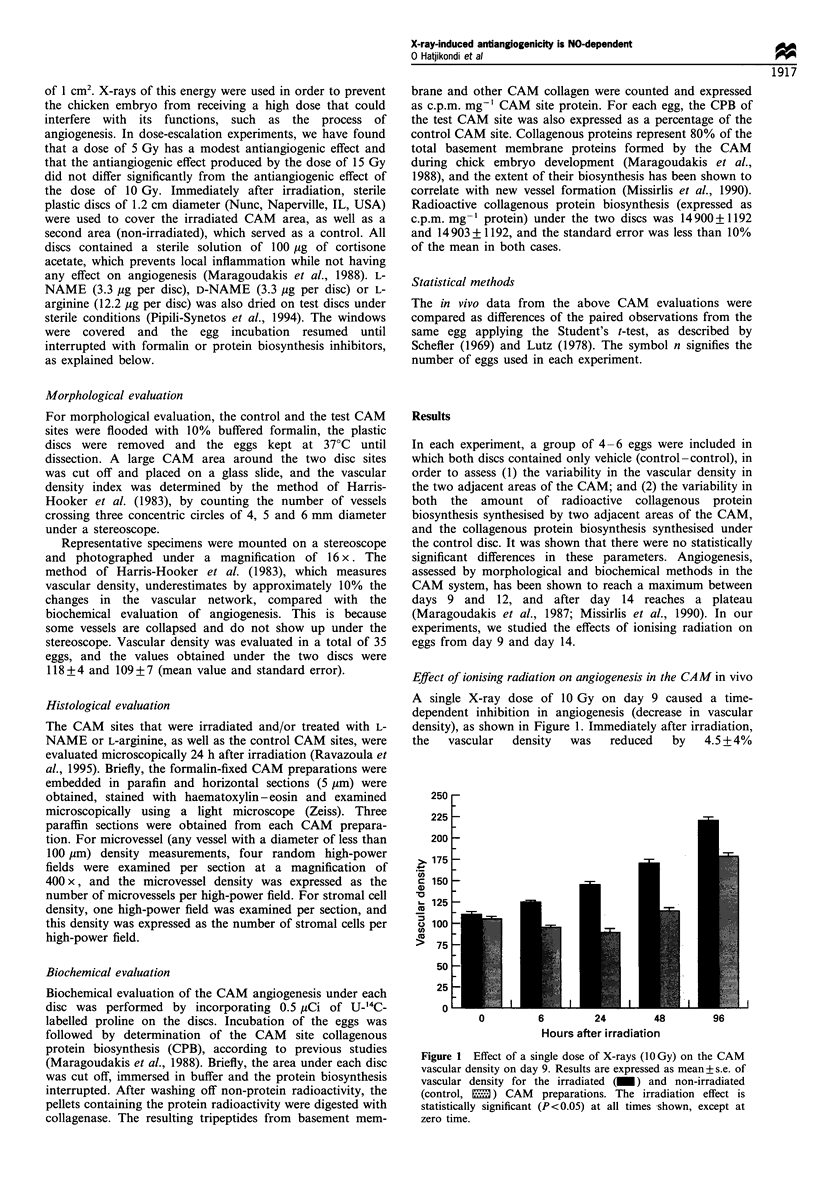

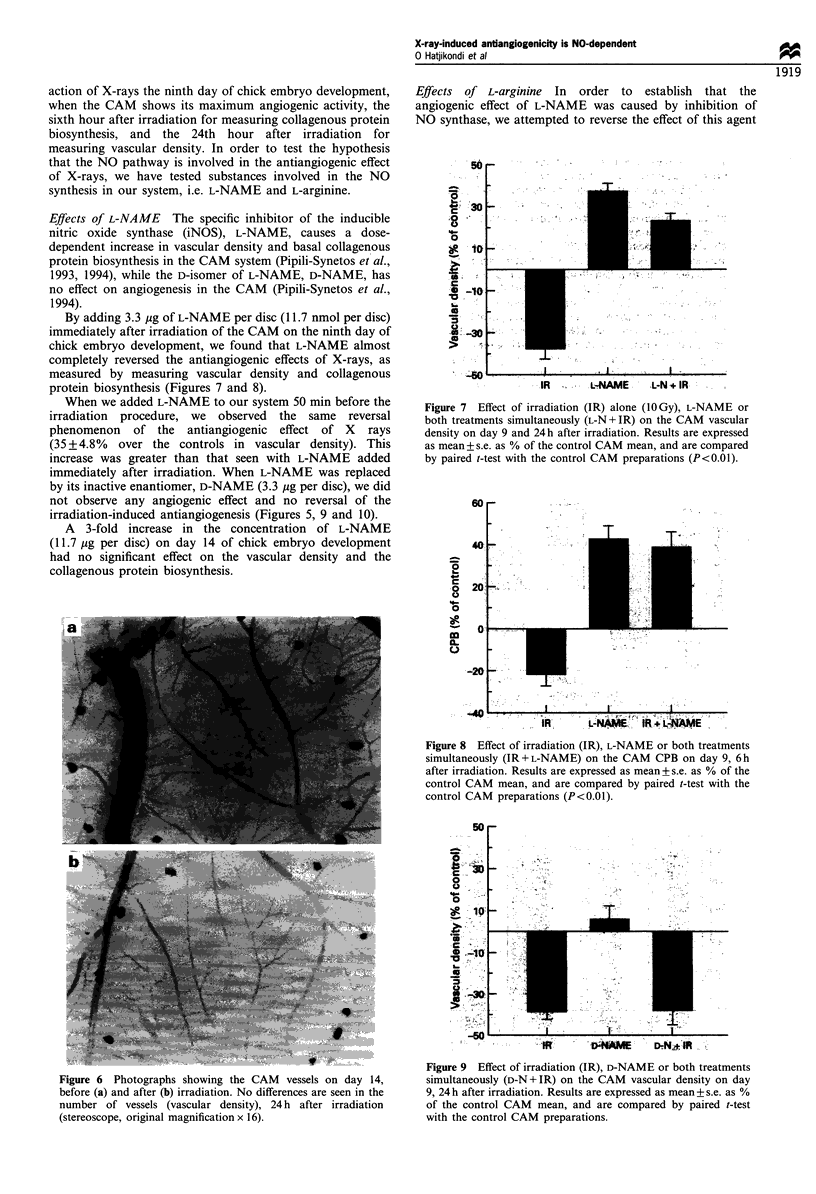
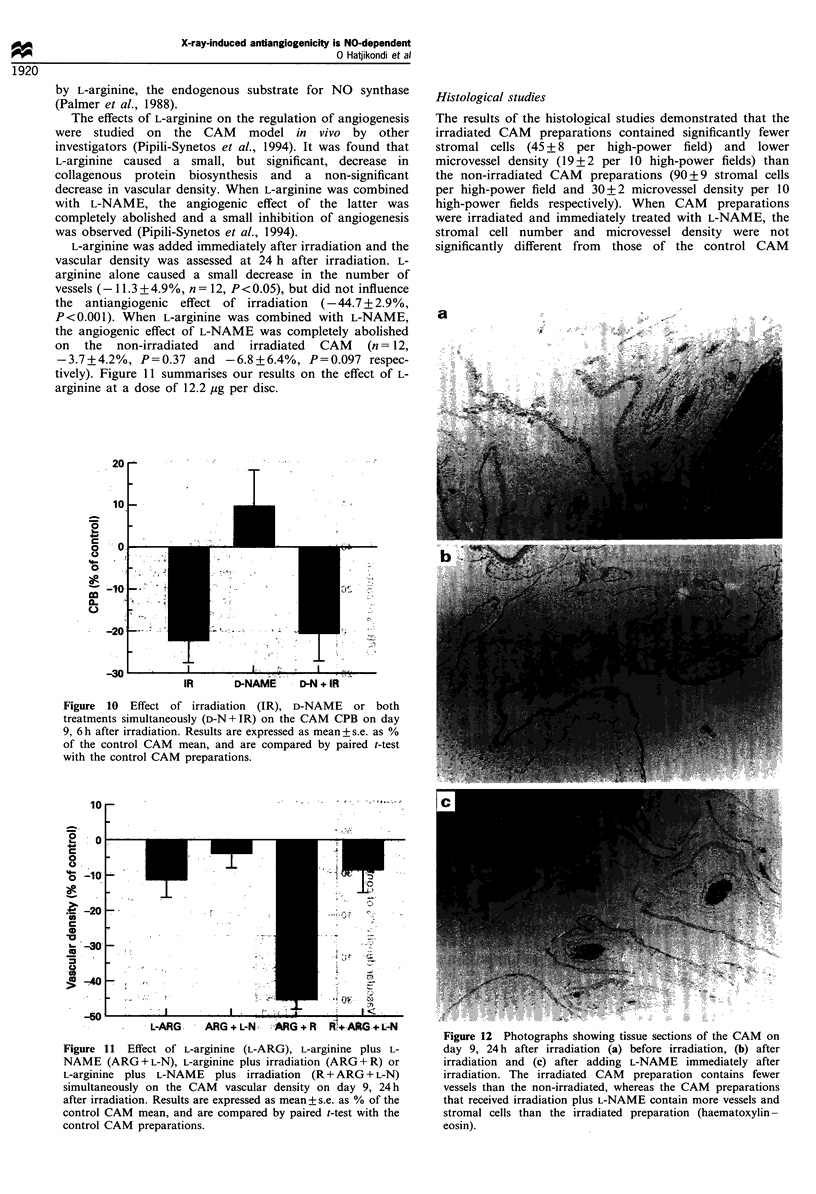
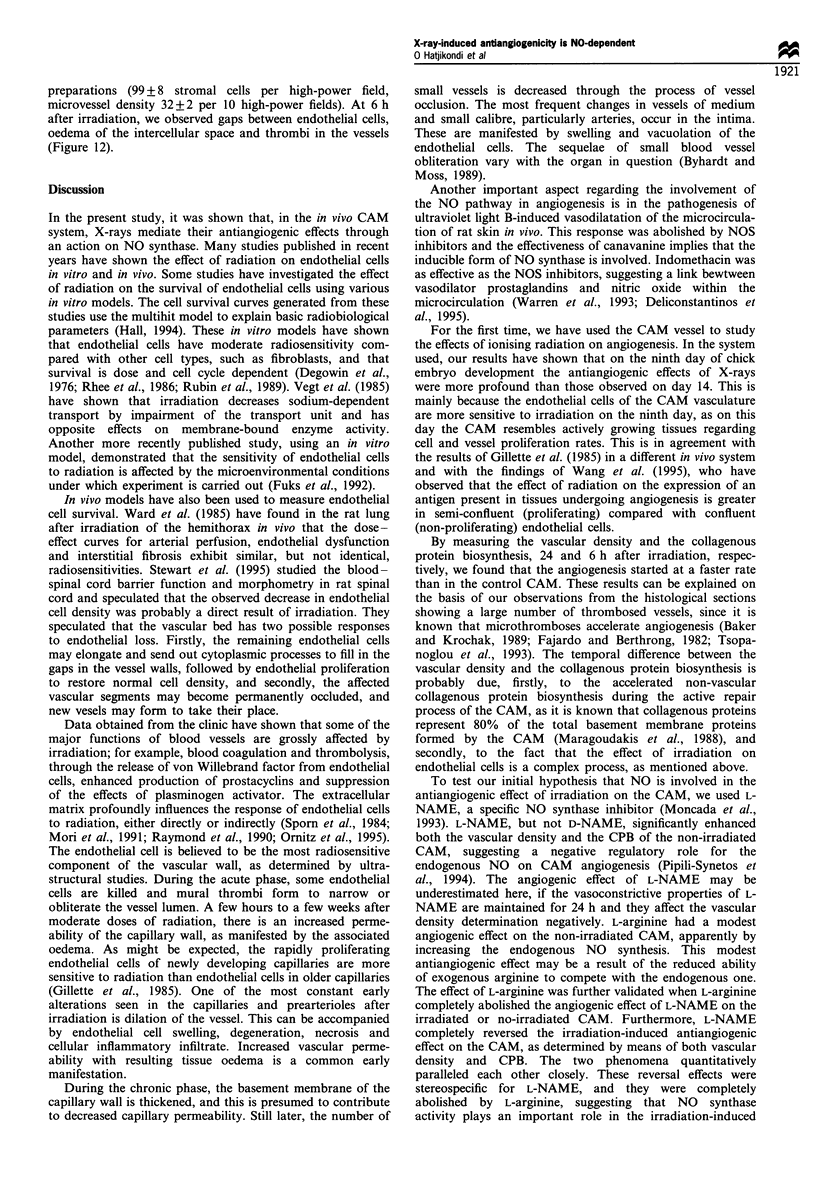
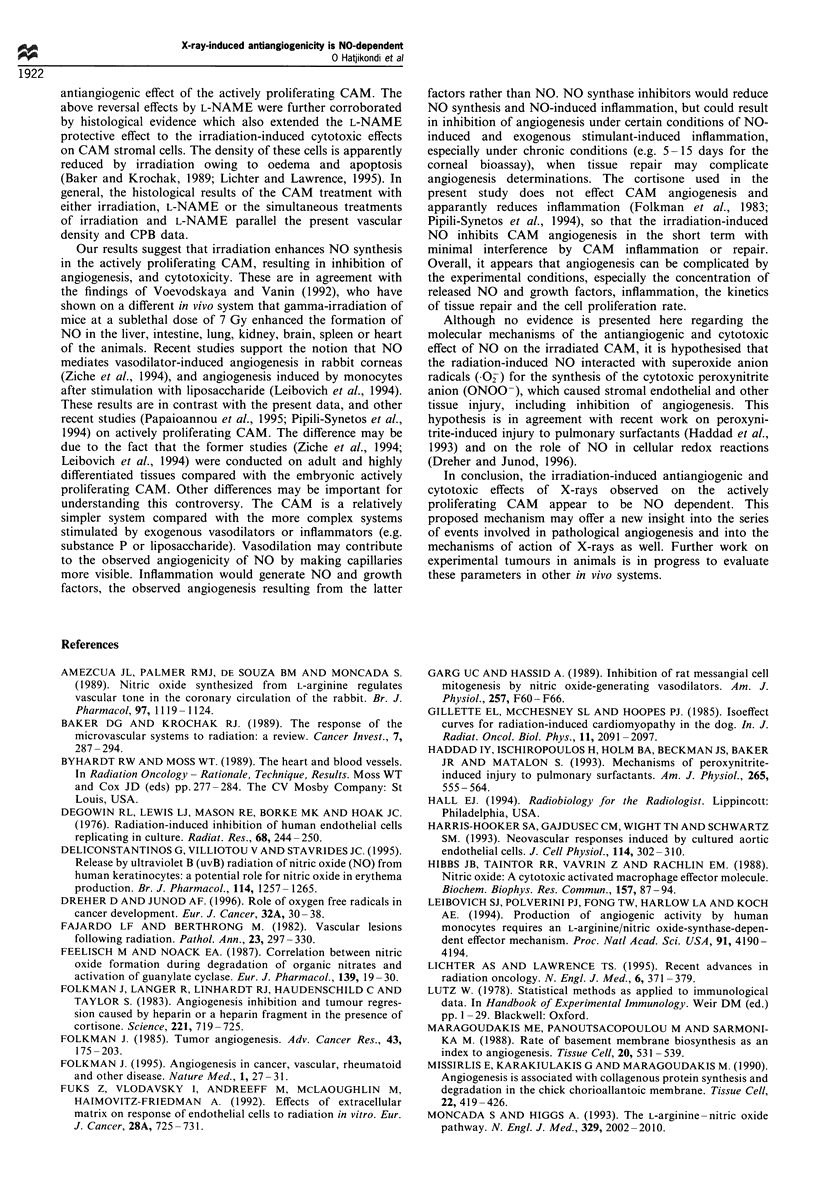
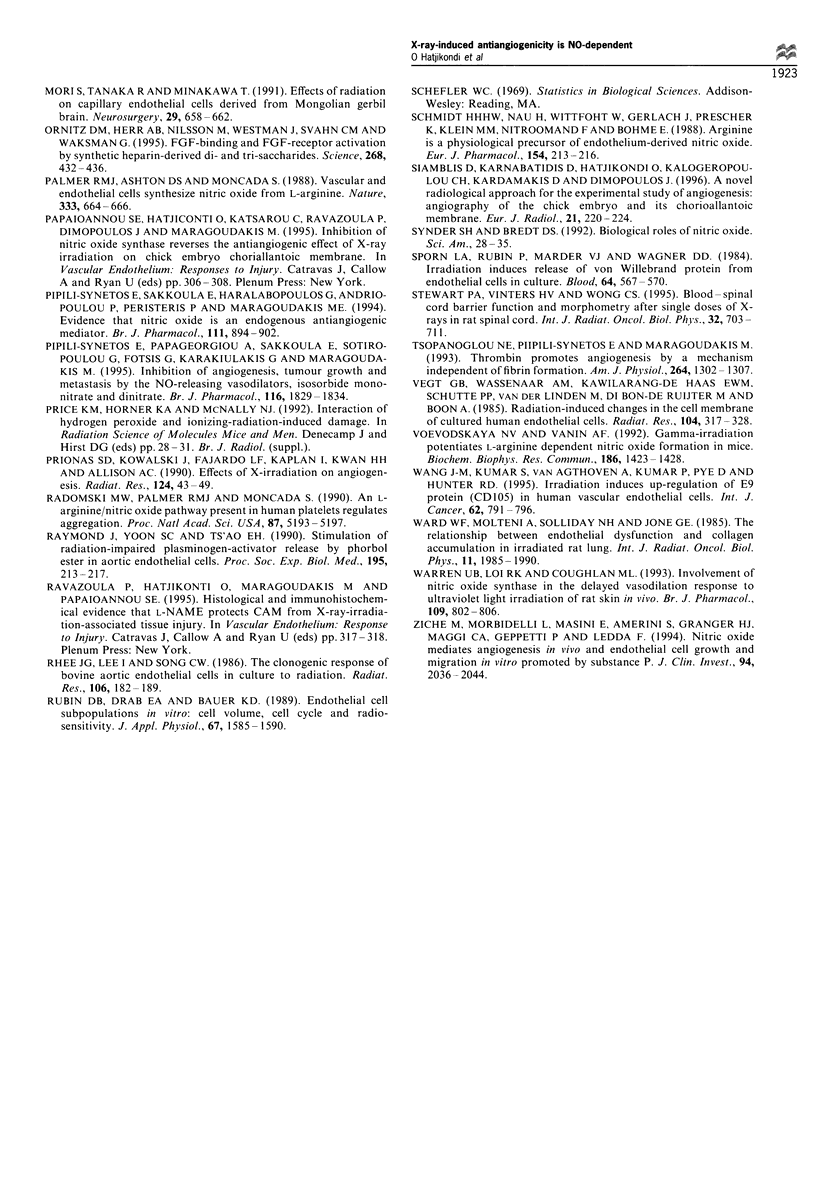
Images in this article
Selected References
These references are in PubMed. This may not be the complete list of references from this article.
- Amezcua J. L., Palmer R. M., de Souza B. M., Moncada S. Nitric oxide synthesized from L-arginine regulates vascular tone in the coronary circulation of the rabbit. Br J Pharmacol. 1989 Aug;97(4):1119–1124. doi: 10.1111/j.1476-5381.1989.tb12569.x. [DOI] [PMC free article] [PubMed] [Google Scholar]
- Baker D. G., Krochak R. J. The response of the microvascular system to radiation: a review. Cancer Invest. 1989;7(3):287–294. doi: 10.3109/07357908909039849. [DOI] [PubMed] [Google Scholar]
- DeGowin R. L., Lewis L. J., Mason R. E., Borke M. K., Hoak J. C. Radiation-induced inhibition of human endothelial cells replicating in culture. Radiat Res. 1976 Nov;68(2):244–250. [PubMed] [Google Scholar]
- Deliconstantinos G., Villiotou V., Stravrides J. C. Release by ultraviolet B (u.v.B) radiation of nitric oxide (NO) from human keratinocytes: a potential role for nitric oxide in erythema production. Br J Pharmacol. 1995 Mar;114(6):1257–1265. doi: 10.1111/j.1476-5381.1995.tb13341.x. [DOI] [PMC free article] [PubMed] [Google Scholar]
- Dreher D., Junod A. F. Role of oxygen free radicals in cancer development. Eur J Cancer. 1996 Jan;32A(1):30–38. doi: 10.1016/0959-8049(95)00531-5. [DOI] [PubMed] [Google Scholar]
- Fajardo L. F., Berthrong M. Vascular lesions following radiation. Pathol Annu. 1988;23(Pt 1):297–330. [PubMed] [Google Scholar]
- Feelisch M., Noack E. A. Correlation between nitric oxide formation during degradation of organic nitrates and activation of guanylate cyclase. Eur J Pharmacol. 1987 Jul 2;139(1):19–30. doi: 10.1016/0014-2999(87)90493-6. [DOI] [PubMed] [Google Scholar]
- Folkman J. Angiogenesis in cancer, vascular, rheumatoid and other disease. Nat Med. 1995 Jan;1(1):27–31. doi: 10.1038/nm0195-27. [DOI] [PubMed] [Google Scholar]
- Folkman J., Langer R., Linhardt R. J., Haudenschild C., Taylor S. Angiogenesis inhibition and tumor regression caused by heparin or a heparin fragment in the presence of cortisone. Science. 1983 Aug 19;221(4612):719–725. doi: 10.1126/science.6192498. [DOI] [PubMed] [Google Scholar]
- Folkman J. Tumor angiogenesis. Adv Cancer Res. 1985;43:175–203. doi: 10.1016/s0065-230x(08)60946-x. [DOI] [PubMed] [Google Scholar]
- Fuks Z., Vlodavsky I., Andreeff M., McLoughlin M., Haimovitz-Friedman A. Effects of extracellular matrix on the response of endothelial cells to radiation in vitro. Eur J Cancer. 1992;28A(4-5):725–731. doi: 10.1016/0959-8049(92)90104-a. [DOI] [PubMed] [Google Scholar]
- Garg U. C., Hassid A. Inhibition of rat mesangial cell mitogenesis by nitric oxide-generating vasodilators. Am J Physiol. 1989 Jul;257(1 Pt 2):F60–F66. doi: 10.1152/ajprenal.1989.257.1.F60. [DOI] [PubMed] [Google Scholar]
- Gillette E. L., McChesney S. L., Hoopes P. J. Isoeffect curves for radiation-induced cardiomyopathy in the dog. Int J Radiat Oncol Biol Phys. 1985 Dec;11(12):2091–2097. doi: 10.1016/0360-3016(85)90089-6. [DOI] [PubMed] [Google Scholar]
- Harris-Hooker S. A., Gajdusek C. M., Wight T. N., Schwartz S. M. Neovascular responses induced by cultured aortic endothelial cells. J Cell Physiol. 1983 Mar;114(3):302–310. doi: 10.1002/jcp.1041140308. [DOI] [PubMed] [Google Scholar]
- Hibbs J. B., Jr, Taintor R. R., Vavrin Z., Rachlin E. M. Nitric oxide: a cytotoxic activated macrophage effector molecule. Biochem Biophys Res Commun. 1988 Nov 30;157(1):87–94. doi: 10.1016/s0006-291x(88)80015-9. [DOI] [PubMed] [Google Scholar]
- Leibovich S. J., Polverini P. J., Fong T. W., Harlow L. A., Koch A. E. Production of angiogenic activity by human monocytes requires an L-arginine/nitric oxide-synthase-dependent effector mechanism. Proc Natl Acad Sci U S A. 1994 May 10;91(10):4190–4194. doi: 10.1073/pnas.91.10.4190. [DOI] [PMC free article] [PubMed] [Google Scholar]
- Lichter A. S., Lawrence T. S. Recent advances in radiation oncology. N Engl J Med. 1995 Feb 9;332(6):371–379. doi: 10.1056/NEJM199502093320607. [DOI] [PubMed] [Google Scholar]
- Maragoudakis M. E., Panoutsacopoulou M., Sarmonika M. Rate of basement membrane biosynthesis as an index to angiogenesis. Tissue Cell. 1988;20(4):531–539. doi: 10.1016/0040-8166(88)90055-9. [DOI] [PubMed] [Google Scholar]
- Missirlis E., Karakiulakis G., Maragoudakis M. E. Angiogenesis is associated with collagenous protein synthesis and degradation in the chick chorioallantoic membrane. Tissue Cell. 1990;22(4):419–426. doi: 10.1016/0040-8166(90)90071-g. [DOI] [PubMed] [Google Scholar]
- Moncada S., Higgs A. The L-arginine-nitric oxide pathway. N Engl J Med. 1993 Dec 30;329(27):2002–2012. doi: 10.1056/NEJM199312303292706. [DOI] [PubMed] [Google Scholar]
- Mori S., Tanaka R., Minakawa T. Effects of radiation on capillary endothelial cells derived from Mongolian gerbil brain. Neurosurgery. 1991 Nov;29(5):658–662. doi: 10.1097/00006123-199111000-00003. [DOI] [PubMed] [Google Scholar]
- Ornitz D. M., Herr A. B., Nilsson M., Westman J., Svahn C. M., Waksman G. FGF binding and FGF receptor activation by synthetic heparan-derived di- and trisaccharides. Science. 1995 Apr 21;268(5209):432–436. doi: 10.1126/science.7536345. [DOI] [PubMed] [Google Scholar]
- Palmer R. M., Ashton D. S., Moncada S. Vascular endothelial cells synthesize nitric oxide from L-arginine. Nature. 1988 Jun 16;333(6174):664–666. doi: 10.1038/333664a0. [DOI] [PubMed] [Google Scholar]
- Pipili-Synetos E., Papageorgiou A., Sakkoula E., Sotiropoulou G., Fotsis T., Karakiulakis G., Maragoudakis M. E. Inhibition of angiogenesis, tumour growth and metastasis by the NO-releasing vasodilators, isosorbide mononitrate and dinitrate. Br J Pharmacol. 1995 Sep;116(2):1829–1834. doi: 10.1111/j.1476-5381.1995.tb16670.x. [DOI] [PMC free article] [PubMed] [Google Scholar]
- Pipili-Synetos E., Sakkoula E., Haralabopoulos G., Andriopoulou P., Peristeris P., Maragoudakis M. E. Evidence that nitric oxide is an endogenous antiangiogenic mediator. Br J Pharmacol. 1994 Mar;111(3):894–902. doi: 10.1111/j.1476-5381.1994.tb14822.x. [DOI] [PMC free article] [PubMed] [Google Scholar]
- Prionas S. D., Kowalski J., Fajardo L. F., Kaplan I., Kwan H. H., Allison A. C. Effects of X irradiation on angiogenesis. Radiat Res. 1990 Oct;124(1):43–49. [PubMed] [Google Scholar]
- Prise K. M., Horner K. A., McNally N. J. Interaction of hydrogen peroxide and ionizing-radiation-induced damage. BJR Suppl. 1992;24:28–31. [PubMed] [Google Scholar]
- Radomski M. W., Palmer R. M., Moncada S. An L-arginine/nitric oxide pathway present in human platelets regulates aggregation. Proc Natl Acad Sci U S A. 1990 Jul;87(13):5193–5197. doi: 10.1073/pnas.87.13.5193. [DOI] [PMC free article] [PubMed] [Google Scholar]
- Raymond J., Yoon S. C., Ts'ao C. H. Stimulation of radiation-impaired plasminogen activator release by phorbol ester in aortic endothelial cells. Proc Soc Exp Biol Med. 1990 Nov;195(2):213–217. doi: 10.3181/00379727-195-43137. [DOI] [PubMed] [Google Scholar]
- Rhee J. G., Lee I., Song C. W. The clonogenic response of bovine aortic endothelial cells in culture to radiation. Radiat Res. 1986 May;106(2):182–189. [PubMed] [Google Scholar]
- Rubin D. B., Drab E. A., Bauer K. D. Endothelial cell subpopulations in vitro: cell volume, cell cycle, and radiosensitivity. J Appl Physiol (1985) 1989 Oct;67(4):1585–1590. doi: 10.1152/jappl.1989.67.4.1585. [DOI] [PubMed] [Google Scholar]
- Schmidt H. H., Nau H., Wittfoht W., Gerlach J., Prescher K. E., Klein M. M., Niroomand F., Böhme E. Arginine is a physiological precursor of endothelium-derived nitric oxide. Eur J Pharmacol. 1988 Sep 13;154(2):213–216. doi: 10.1016/0014-2999(88)90101-x. [DOI] [PubMed] [Google Scholar]
- Siamblis D., Karnabatidis D., Hatjikondi O., Kalogeropoulou C., Kardamakis D., Dimopoulos J. A novel radiological approach for the experimental study of angiogenesis: angiography of the chick embryo and its chorioallantoic membrane. Eur J Radiol. 1996 Feb;21(3):220–224. doi: 10.1016/0720-048X(95)00714-2. [DOI] [PubMed] [Google Scholar]
- Sporn L. A., Rubin P., Marder V. J., Wagner D. D. Irradiation induces release of von Willebrand protein from endothelial cells in culture. Blood. 1984 Aug;64(2):567–570. [PubMed] [Google Scholar]
- Stewart P. A., Vinters H. V., Wong C. S. Blood-spinal cord barrier function and morphometry after single doses of x-rays in rat spinal cord. Int J Radiat Oncol Biol Phys. 1995 Jun 15;32(3):703–711. doi: 10.1016/0360-3016(94)00594-B. [DOI] [PubMed] [Google Scholar]
- Vegt G. B., Wassenaar A. M., Kawilarang-de Haas E. W., Schütte P. P., van der Linden M., Di Bon-de Ruijter M., Boon A. Radiation-induced changes in the cell membrane of cultured human endothelial cells. Radiat Res. 1985 Dec;104(3):317–328. [PubMed] [Google Scholar]
- Voevodskaya N. V., Vanin A. F. Gamma-irradiation potentiates L-arginine-dependent nitric oxide formation in mice. Biochem Biophys Res Commun. 1992 Aug 14;186(3):1423–1428. doi: 10.1016/s0006-291x(05)81565-7. [DOI] [PubMed] [Google Scholar]
- Wang J. M., Kumar S., van Agthoven A., Kumar P., Pye D., Hunter R. D. Irradiation induces up-regulation of E9 protein (CD105) in human vascular endothelial cells. Int J Cancer. 1995 Sep 15;62(6):791–796. doi: 10.1002/ijc.2910620624. [DOI] [PubMed] [Google Scholar]
- Ward W. F., Molteni A., Solliday N. H., Jones G. E. The relationship between endothelial dysfunction and collagen accumulation in irradiated rat lung. Int J Radiat Oncol Biol Phys. 1985 Nov;11(11):1985–1990. doi: 10.1016/0360-3016(85)90281-0. [DOI] [PubMed] [Google Scholar]
- Warren J. B., Loi R. K., Coughlan M. L. Involvement of nitric oxide synthase in the delayed vasodilator response to ultraviolet light irradiation of rat skin in vivo. Br J Pharmacol. 1993 Jul;109(3):802–806. doi: 10.1111/j.1476-5381.1993.tb13645.x. [DOI] [PMC free article] [PubMed] [Google Scholar]
- Ziche M., Morbidelli L., Masini E., Amerini S., Granger H. J., Maggi C. A., Geppetti P., Ledda F. Nitric oxide mediates angiogenesis in vivo and endothelial cell growth and migration in vitro promoted by substance P. J Clin Invest. 1994 Nov;94(5):2036–2044. doi: 10.1172/JCI117557. [DOI] [PMC free article] [PubMed] [Google Scholar]



